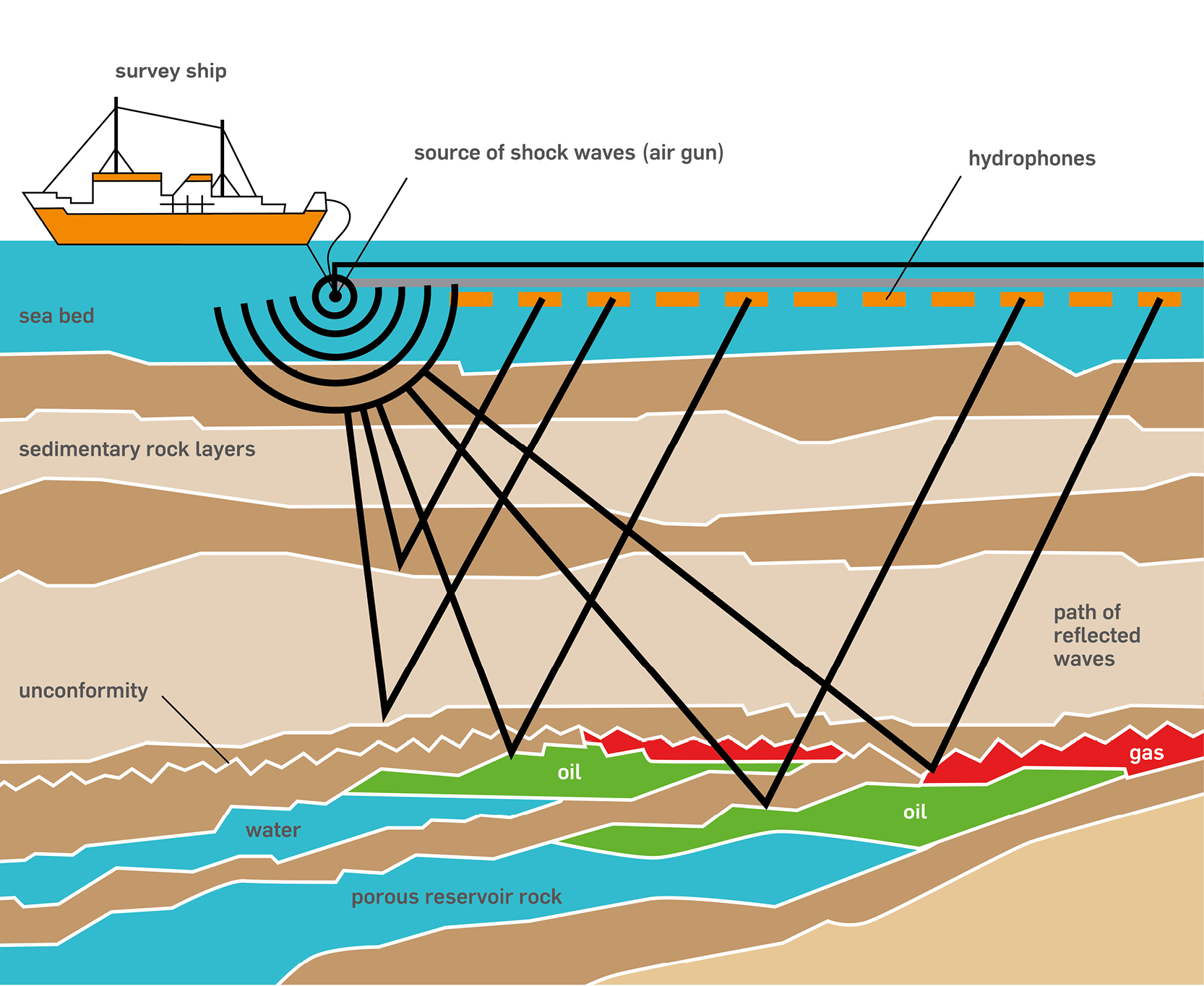You can’t get the hydrocarbons beneath the earth without drilling a borehole, drilling is an essential process in oil and gas industry as it happens in every stage of the development of the field.
What is a Well?
An oil or gas well is the term for any perforation through the earth’s surface designed to find and release oil and gas hydrocarbons. In summary, a well is created by drilling a hole into the earth with a drilling rig that rotates a drill string with a bit attached.
After the hole is drilled to an anticipated depth, sections of steel tubing known as casing are set in the hole (slightly smaller than the borehole) to provide an annulus for cementing. The casing provides structural integrity to the newly drilled wellbore and isolates any potentially dangerous high pressure zones from each other and from the surface.
With these zones safely isolated and the formation protected by the casing, the well can then be drilled deeper, often into potentially more unstable formations. Here, a smaller bit and smaller size casing is used. Modern wells often have 2-5 sets of subsequently smaller hole sizes drilled, each inside one another and each cemented with a different size of casing.

Onshore and offshore drilling preparation
The drilling rig is a complex structure that is used to penetrate the surface and create a hole into the earth’s crust. Depend on location and the task of operation, the drilling rig can be mobile equipment mounted on trucks or permanent land or marine-based structures such as vessels (drilling ships), permanent production platform or drilling platform, which is commonly called offshore oil rigs.
The site for drilling operations must be prepared before the well can be drilled, including leveling the land on which the rig will be assembled. Access roads must be created so workers and equipment or disposal can get to and from the drilling site. It is more complex for offshore operations, an offshore rig or production platform is a small society or city with many support functions, including: cafeteria, sleeping quarters, entertainment halls and management teams. All equipment, supplies and waste must be constantly transported in and out by work boat.

Spudding in:
All drilling rigs have hoisting system to raise and lower drill pipe or equipment and tools needed to drill the well, including power system, blowout preventers (POBs) and pumping system for circulating fluids in and out of the well while drilling. The start of drilling is very commonly referred to as “spudding in”, begins with drilling a large-diameter but shallow hole. This is referred to as a conductor hole and is typically 20-60 meters deep. Once drilled, it is lined with conductor casing and cemented into place. Conductor casing is used to keep the top of the wellbore from collapsing in on itself. Next step is to drill another smaller diameter hole with the depth is approximately 100 to 150 meters to seal off surface water aquifers, stabilize the top of the well and provide an attachment for the POBs at the wellhead. It is very important to make this hole as all subsequent drilling operations will be based on this first hole. Once the BOPs are activated, the true well drilling begins towards the target depth and reservoir.
Drilling bits and mud circulating system:
A drill bit is an essential device, securely attached to the end of the drill string that breaks apart, cuts or crushes the rock formations when drilling a well. Everything on a drilling rig assists the bit in cutting the rock. The bit is on the bottom of the drill string and must be changed when it becomes excessively dull or stops making progress and it can take days on a deep well. Therefore, bits are designed to work with intensity as long as possible. Most bits work by scraping or crushing or both the rock as part of a rotational motion. The drill bit is hollow and has jets to allow for the expulsion of the drilling fluid (mud) at high velocity and high pressure. Through the drill pipes, at the extremity of which the drill bit rotates drilling mud with specific properties is injected to lubricate, cool and clean the drilling bit, remove drill bit cuttings from the bottom of the hole, control downhole pressure and stabilize the wall of the borehole by creating greater hydrostatic pressure than the formation pressure itself.
Each drilling fluid is a highly engineered substance that is customized for each specific well application. The mud chemical substance is monitored closely and changed throughout the drilling process to deal with any new geological and operational conditions that occur in downhole. The cuttings from wellbore have to be analyzed by geologists to discover the characteristics of the rocks being drilled and to detect any evidence of hydrocarbons appearance. There many types of drilling bit and which will be used depend on the rock properties and purposes of drilling operations such as core sampling for analysis or directional drilling in horizontal wells, takes into account of planning time and economic factors.
Casing and cementing:
Another important operation during drilling process are running casing and cementing, the whole point of this is to hold the casing, provide integrity of wellbore and conduit from the surface to the producing zones, prevent fluid migration between formations. Before cementing operations commence, engineers determine the volume and the required physical properties of both the slurry and the set cement, then cement is pumped up the annulus between the casing and the actual borehole wall and seal it.
Drilling process
Fishing:
Fishing is the process of removing tools, equipment and, debris, all are called fish, that have accidentally been dropped or broken in down-hole. The key elements of a fishing operation include: an understanding of the dimensions and nature of the fish to be removed, the wellbore conditions, the tools and techniques employed, and the process to handle the recovered fish at surface. Fishing is a specialized process in drilling operations. It has the potential to save drilling companies huge amounts of money by providing a service that retrieves objects down-hole rather than abandoning the well altogether.
Kick and Detection:
Kick is the term for the situation where reservoir fluids flow into the wellbore during drilling operations. The kick occurs when the hydrostatic pressure in the wellbore is less than that of the formation fluids, thus causing flow. This condition is caused in two ways: If the mud density is suddenly lightened or if a drilled formation has a higher pressure than anticipated. This type of kick is called an underbalanced kick. The second way a kick can occur is due to the motion of the drill string or casing, effectively lowering the pressure in the wellbore below that of the formation.
Detection is the process of identifying key indicators of a kick before a kick actually occurs. There are always signs of impending well kick and a number of instruments are used to detect these signs. If a well kick is left unchecked it can result in a sub-surface or worse a surface well blowout.
Well control
There are many unpredicted situations may occur in drilling process, therefore, well control system and control measures must be applied in these situation. Drilling progress is monitored and managed using Measurement While Drilling (MWD) technology, in which instruments monitor variables in the borehole, such as position, temperature, pressure and porosity. These data are transmitted back to the surface through pressure changes in the drilling mud. Examining cuttings extracted from the mud is known as mud logging. Another form of well logging is electronic and is frequently employed to evaluate the existence of possible oil and gas deposits in the borehole. The ability to do mud logging and real time cuttings analysis provides immediate data on the rocks being penetrated and eliminates the need to pull the drill string out of the borehole.
Often, “downhole blowouts” can occur when a zone of high pressure is penetrated and uncontrolled pressure starts flowing to another zone of lower pressure. It occurs during drilling operations or in production fields if the casing and tubing starts to corrode and deteriorate. To control this situation three well control measures are used:
Primary Well Control – Here, mud pressure is increased above the pressure in the formation. This form of well control is maintained and closely monitored throughout the entire well drilling process.
Secondary Well Control – A BOP stack is activated which seals off the well annulus to prevent the downhole pressure from reaching the surface.
Tertiary Well Control – In extreme situations, to contain the downhole pressure, a chemical compound is pumped into the well bore to counteract the flow at the zone of high pressure. One of the most common is a barite (a very heavy solid) and oil mixture. The materials solidify as it is pumped into the wellbore and is often referred to as a barite plug.
Plugging the flow path with barite is rarely effective in controlling a significant underground flow. If alternative drilling paths are not readily available to get to the reservoir, cement is pumped down the bore hole and the well is abandoned. A barite plug is tried first then cement is used if situation continues to be unstable.
Well control process
Killing the Well:
Killing the well is the process used totally stop a well from flowing. A well kill refers to the operation of placing a column of heavy fluid into a well bore to prevent the flow of reservoir fluids to the surface. It works on the principle that the weight of the “kill fluid” or “kill mud” will be enough to suppress the pressure of the fluids in the formation.
In case of sudden kick from a high pressure area such as gas cap, that can’t be controlled with standard well control techniques, it can become necessary to kill the well for safety. This is done by pumping kill mud (like the barite plug compound) or cement down the drill pipe, where it circulates out the bottom and into the well bore.
On average, an onshore oil well costs between $4.9 MM and $8.3 MM in total well capital costs, an offshore well costs are higher respectively due to the increased difficulty of drilling in deep water and the infrastructure required for the operations. We can see that if anything happens during drilling process that leads to inefficiency of the process or killing the well, or worse, results an environmental disaster when oil and gas blow out occur, it would become a catastrophe for the company. Therefore, drilling operation and activities accompanied with it are extremely important and have been paid attention by E&P companies. More modern technologies and new techniques have been implementing with the sole purpose of making drilling process smoother and safer.





